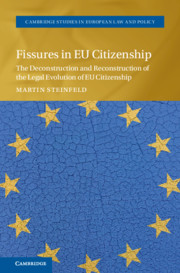 Fissures in EU Citizenship
Fissures in EU Citizenship Book contents
- Fissures in EU Citizenship
- Cambridge Studies in European Law and Policy
- Fissures in EU Citizenship
- Copyright page
- Epigraph
- Contents
- Acknowledgments
- Preface
- Introduction: Contaminated Citizenship
- Part I Fissures in the Foundations of the Temple
- Part II The Crumbling Pillars of the Temple
- Part III Could the Roof of the Temple Cave in?
- Bibliography
- Index
- Series page
Introduction: Contaminated Citizenship
Published online by Cambridge University Press: 11 January 2022
- Fissures in EU Citizenship
- Cambridge Studies in European Law and Policy
- Fissures in EU Citizenship
- Copyright page
- Epigraph
- Contents
- Acknowledgments
- Preface
- Introduction: Contaminated Citizenship
- Part I Fissures in the Foundations of the Temple
- Part II The Crumbling Pillars of the Temple
- Part III Could the Roof of the Temple Cave in?
- Bibliography
- Index
- Series page
Summary
It is possible that had a vote by one of the largest Member States of the European Union on the very membership upon which Citizenship is predicated not taken place in June 2016 during an era of Pan-European populism, a critical deconstructivist approach to the evolution of free movement of persons law might have had purely academic relevance. Whilst European Union Citizenship was ‘born’ in 1992 after the original Treaty of Rome was amended to include Articles 17 and 18, its roots can be excavated to a much earlier period and this book, in a sense, seeks to replicate the Greek Temple façade envisioned by the Maastricht Treaty and examine the structure from its foundations upwards. As early as 1976, Plender famously stated that European Citizenship was ‘incipient’.
- Type
- Chapter
- Information
- Fissures in EU CitizenshipThe Deconstruction and Reconstruction of the Legal Evolution of EU Citizenship, pp. 1 - 36Publisher: Cambridge University PressPrint publication year: 2022
